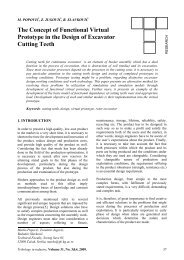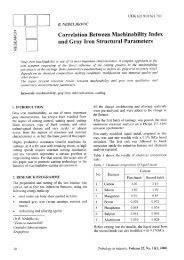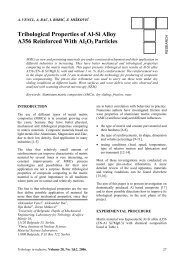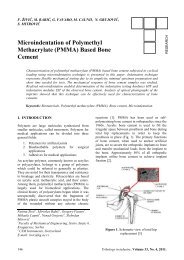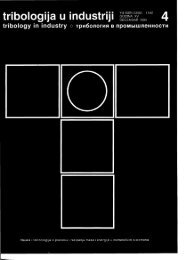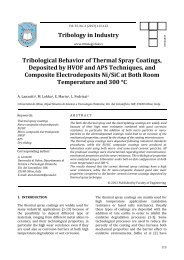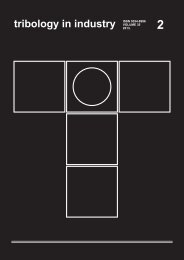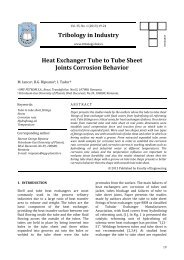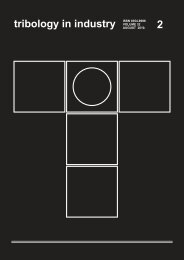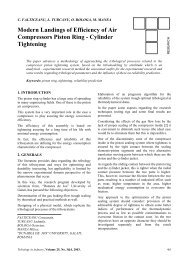Considering Bearing Curves of Roughness on Face Mitled Surfaces ...
Considering Bearing Curves of Roughness on Face Mitled Surfaces ...
Considering Bearing Curves of Roughness on Face Mitled Surfaces ...
- No tags were found...
You also want an ePaper? Increase the reach of your titles
YUMPU automatically turns print PDFs into web optimized ePapers that Google loves.
G, PETROPOALOS, C. PANDAZARAS,uDK 67e.8.057:62t.st4.2[l[l|--_-lI. STAMOS I II II ITC)tLIJU)r!tnIThe present c<strong>on</strong>tributi<strong>on</strong> describes the statistical analysis <str<strong>on</strong>g>of</str<strong>on</strong>g> bearing (Abbott) curves <str<strong>on</strong>g>of</str<strong>on</strong>g> surfaceroughness prociuced by face milling <str<strong>on</strong>g>of</str<strong>on</strong>g> steel. <str<strong>on</strong>g>Bearing</str<strong>on</strong>g> curves parameters are found to closelycorrelate with feed rate and other surface texture parameters and to follow asymmetricaldistributi<strong>on</strong>s over milled surfaces, Furthermore, bearing curves cre modelled through Beta andP ears<strong>on</strong> statistical systems.<str<strong>on</strong>g>C<strong>on</strong>sidering</str<strong>on</strong>g> <str<strong>on</strong>g>Bearing</str<strong>on</strong>g> <str<strong>on</strong>g>Curves</str<strong>on</strong>g> <str<strong>on</strong>g>of</str<strong>on</strong>g> <str<strong>on</strong>g>Roughness</str<strong>on</strong>g><strong>on</strong> <strong>Face</strong> <strong>Mitled</strong> <strong>Surfaces</strong> <str<strong>on</strong>g>of</str<strong>on</strong>g> SteelKeywords: surface roughness, bearing curve and parameters, statistical distributi<strong>on</strong>s, Beta andPears<strong>on</strong> slstems, metal machining, face milling, corb<strong>on</strong> steels1. INTRODUCTIONMilling operati<strong>on</strong>s are am<strong>on</strong>g the most popularremoval processes in manufacturing industry.Especially, face milling is widely used in advancedmachine tools and systems (CNC, IMS etc), wherethere are high requirements for precise predictivemodels <str<strong>on</strong>g>of</str<strong>on</strong>g> basic machinability parameters. Such afactor is surface roughness seriously afflectingcomp<strong>on</strong>ents tribological performance [1-2].<str<strong>on</strong>g>Roughness</str<strong>on</strong>g> <str<strong>on</strong>g>of</str<strong>on</strong>g> engineering surfaces is expressed byvarious parameters, arithmetic and statistical. One <str<strong>on</strong>g>of</str<strong>on</strong>g>the latter is bearing area or Abbott curve; it providesrepresentati<strong>on</strong> <str<strong>on</strong>g>of</str<strong>on</strong>g> the existing material in variousheights <str<strong>on</strong>g>of</str<strong>on</strong>g> the surface pr<str<strong>on</strong>g>of</str<strong>on</strong>g>ile and corresp<strong>on</strong>ds tocumulative probability <str<strong>on</strong>g>of</str<strong>on</strong>g> pr<str<strong>on</strong>g>of</str<strong>on</strong>g>ile amplitudedistributi<strong>on</strong>. By virtue <str<strong>on</strong>g>of</str<strong>on</strong>g> being statistical, bearingcurves and corresp<strong>on</strong>ding parameters may describewell wear performance <str<strong>on</strong>g>of</str<strong>on</strong>g> surfaces under sliding andfeed surface c<strong>on</strong>tact models. On the other hand, theyare closely associated with the manufacturing processapplied and this is the reas<strong>on</strong> why they areestablished in surface texture analysis in view <str<strong>on</strong>g>of</str<strong>on</strong>g> bothtribology and manufacturing science [3-4].In the present study the correlati<strong>on</strong> between bearingparameters and cutting c<strong>on</strong>diti<strong>on</strong>s is investigated inface milling <str<strong>on</strong>g>of</str<strong>on</strong>g> steel, as well as the relevant bearingcurves are represented and modelled via statisticalfuncti<strong>on</strong>s. Also, the statistical distributi<strong>on</strong>s <str<strong>on</strong>g>of</str<strong>on</strong>g> bearingG. Petropoulos,C. Pandazaras,L StomosDepctrtment <str<strong>on</strong>g>of</str<strong>on</strong>g> Mechanical and IndustrialEngineer ing, Univers ity <str<strong>on</strong>g>of</str<strong>on</strong>g> Thess alyPedi<strong>on</strong> Areos, 38334 Volos, GREECEparameters over the milled surfaces are determined.The workpiece material was a Ck60 plain carb<strong>on</strong>steel for different face milling designati<strong>on</strong>sc<strong>on</strong>sidered.2. EXPERIMENTAL PROCEDURE ANDANALYSISThe vertical knee type milling machine used is <str<strong>on</strong>g>of</str<strong>on</strong>g>medium size in very good working c<strong>on</strong>diti<strong>on</strong> andpossessesufficient static and dynamic stiffness.Cubic specimens (40x40x40) mm' <str<strong>on</strong>g>of</str<strong>on</strong>g> Ck60 plainsteel were face milled.The cutting tools were sintered carbide P40 insertsmounted <strong>on</strong> a standardized five toothed millinqcutter <str<strong>on</strong>g>of</str<strong>on</strong>g> the following geometry:. diameter : 80mm. side angle : 60 "Special attenti<strong>on</strong> was paid for the tools to be keptsharp during the experiments.All experiments were carried out free <str<strong>on</strong>g>of</str<strong>on</strong>g> cutting fluid.Cutting c<strong>on</strong>diti<strong>on</strong>s employed were: depth <str<strong>on</strong>g>of</str<strong>on</strong>g> cuta:0.5 mm, feed rate per tooth s, (0.16-0.60) mm rev' for z:I and (0.03-0..30) mm rev-' for z:5, cuttingspeed v (210) m min -'.The face milling c<strong>on</strong>figurati<strong>on</strong> applied was that <str<strong>on</strong>g>of</str<strong>on</strong>g>approximate coincidence <str<strong>on</strong>g>of</str<strong>on</strong>g> cutter and workpiecegeometrical axes for two designati<strong>on</strong>s, namely <strong>on</strong>etooth (z:l) and five teeth (z:5) engagements.The paper wos published at Seventh YugoslavTribologt C<strong>on</strong>ference YUTNB 2001Tribologt in industry, Volume23, No. 3&4, 2001.51
Surface texture measurements were carried outradialiy with respect to the cutter trace, as this is thedirecti<strong>on</strong> <str<strong>on</strong>g>of</str<strong>on</strong>g> chip thickness variati<strong>on</strong>. A pr<str<strong>on</strong>g>of</str<strong>on</strong>g>ilometerwith a skidless pick-up was used. The cut <str<strong>on</strong>g>of</str<strong>on</strong>g>f length<str<strong>on</strong>g>of</str<strong>on</strong>g> the rolling filter was set at the range (0.8-2.0) mmdepending <strong>on</strong> feed rate value.The bearing ratio parameters c<strong>on</strong>sidered were: Rtpzozand Rtpso%: representing the cross secti<strong>on</strong> <str<strong>on</strong>g>of</str<strong>on</strong>g> surfacematerial at the corresp<strong>on</strong>ding levels and they wereassessed through s<str<strong>on</strong>g>of</str<strong>on</strong>g>fware Talypr<str<strong>on</strong>g>of</str<strong>on</strong>g>. Analyticalbearing curves were calculated via Mathematica asintegrated functi<strong>on</strong>s <str<strong>on</strong>g>of</str<strong>on</strong>g> the Beta and Pears<strong>on</strong>functi<strong>on</strong>s representing corresp<strong>on</strong>ding measuredroughness amplitude di stributi<strong>on</strong>s.The necessary statistical analysis <str<strong>on</strong>g>of</str<strong>on</strong>g> the results wasc<strong>on</strong>ducted via the commercial s<str<strong>on</strong>g>of</str<strong>on</strong>g>tware Statistica.Details <strong>on</strong> the interpretati<strong>on</strong> and modelling <str<strong>on</strong>g>of</str<strong>on</strong>g>bearing curves according to Beta and Fisher-Pears<strong>on</strong>functi<strong>on</strong>s are given elsewhere [5].3. RESULTS AND DISCUSSIONAs a general remark, roughness pr<str<strong>on</strong>g>of</str<strong>on</strong>g>iles in the case <str<strong>on</strong>g>of</str<strong>on</strong>g>the five toothed cutter, especially in the medium tohigh feed rate values, markedly deviate from theregular case appeared when cuttrng with <strong>on</strong>e toothc<strong>on</strong>sidering both shape and amplitude (Fig.1); also,r.vaviness is increased in the former case.An obvious explanati<strong>on</strong> is that the significant threedimensi<strong>on</strong>al eccentricity <str<strong>on</strong>g>of</str<strong>on</strong>g> the cutter with z:5 isresp<strong>on</strong>sible for this effect, as it induces vibrati<strong>on</strong> thatdeteriorates roughness amplitude and <strong>on</strong> the otherhand, successive teeth do not cut at the same depth orsome <str<strong>on</strong>g>of</str<strong>on</strong>g> them do not c<strong>on</strong>tribute at all to the surfacetopography; in c<strong>on</strong>sequence the generated pr<str<strong>on</strong>g>of</str<strong>on</strong>g>ilealthough periodic, is n<strong>on</strong> regular compared to z:lt1l.4. CORRELATION OF BEARING RATIOPAII{METERSA very close correlati<strong>on</strong> is revealed am<strong>on</strong>g bearingratio parameters and feed rate, Ru surface roughnessaverage and W. surface waviness average for the z:1cutter designati<strong>on</strong>. Regarding z:5 cutter anincreasing trend is detected am<strong>on</strong>g bearing ratiosparameters and the aforementi<strong>on</strong>ed quantities,although correlati<strong>on</strong> is fair but that was expectableowing to the very low feed rates and the smaller feedrate values range c<strong>on</strong>sidered. Corresp<strong>on</strong>ding resultsare shown in Fies 2.3 and 4.35.030.025.0- 20.0t'15.010.0o Rtp20%1-aRtp507o,5.00.00 0.2 0.4 0.6 0.8s, [mm rev'l]Figure I a. Surface pr<str<strong>on</strong>g>of</str<strong>on</strong>g>ile machined with I toothedmill cutter (sr:0. I mm rev'' , v:2I0 m min-' )Figure 2a. Measurei Ro parameters for mill cutterwith I tooth against feed rate30.025.0A20.015.010.05.0AAo oo oooo Rtp20%a Rtp50%Figrre Ib. Surfoces pr<str<strong>on</strong>g>of</str<strong>on</strong>g>ile machined with 5 teethmill cutter (s,:0.1 mm reu-t, v:210 m min-t)0.00 0.1 0.2 0.3 0.4s, [mm rev't1Figure 2b. Measured R,, parameters for mill cutterwith 5 teeth againstfeed rate52 Tribolog,, in industry, Volume 23, No. 3&4' 2001.
35.030.025.0^ 20.0u15.010.05.0oAAoi; Rtpro* iia Rtp50% |0.00.0 1.0 2.0 3.0 4.0w. [um]Figure 3a. Measured R*for mill cutter with I toothversus roughness parameter Ro25.02 0.0F r s.o1 0.05.00.00.0 2.0 4.0 6.0 8.0Figure 3b,_ Measured R*for mill cutter with 5 teethversus roughness parameter Ro35.030.025.0o 20.0tr' 15.01n n5.0w' [Fm]Figure 4a. Measured R*Jbr mill cutter with I toothversus waviness parameter Wo30.025.020.015.010 05.06AAio o a ol-1IA0.0 lo0.0 5.0AooooR. [pm ]0.00.0 1.0 2.0 3.0 4.0aoow. [pmlFigure 4b. Measured R,<str<strong>on</strong>g>of</str<strong>on</strong>g>or mill cutter with 5 teethversus waviness porameter WnAAaoAAi1 0.0F Rtpro"/" Ii a Rtp507o lio Rtp20% 1,"Itp!%l5. DISTRIBUTION OF BEARING RATIOPARAMETERS OVER MILLED SURJACESThe distributi<strong>on</strong>s <str<strong>on</strong>g>of</str<strong>on</strong>g> bearing ratio parameters aremodelled after Fisher-Pears<strong>on</strong> statistical system <str<strong>on</strong>g>of</str<strong>on</strong>g>disturbances by 63J" form, see Fig. 5. This factindicates inhomogeneity <str<strong>on</strong>g>of</str<strong>on</strong>g> roughness ascharactertzed by bearing curves and is c<strong>on</strong>sistentwith relevant distributi<strong>on</strong>s <str<strong>on</strong>g>of</str<strong>on</strong>g> amplitude parametersR. and Rt t5l A possible explanati<strong>on</strong> is thatroughness values are locati<strong>on</strong> dependent owing to thevariati<strong>on</strong> <str<strong>on</strong>g>of</str<strong>on</strong>g> cutting force. The latter implies moreintense vibrati<strong>on</strong> and cutter run-out from the start <str<strong>on</strong>g>of</str<strong>on</strong>g>cut towards the cutting trace centre and vice versa.6. REPRESENTATION AND MODELLING OFBEARING CURVESIn Fig. 6 indicative results are presented formeasured curves in comparis<strong>on</strong> to statisticalrepresentati<strong>on</strong>s (Fisher-Pears<strong>on</strong> and Beta functi<strong>on</strong>s).It is evident that there is a satisfactory agreementbetween experimental and calculated data. In thiswoy, bearing curves <str<strong>on</strong>g>of</str<strong>on</strong>g> face milled surfaces may bedescribed for ranges <str<strong>on</strong>g>of</str<strong>on</strong>g> cutting c<strong>on</strong>diti<strong>on</strong>s byappropriate c<strong>on</strong>frolling <str<strong>on</strong>g>of</str<strong>on</strong>g> the relevant statisticaldistributi<strong>on</strong>s parameters., - 1 A6t.a2'1.81.6o ,^E t.z.o4 0.8cG 0.60.40.2Figure 5a. Fisher -Pears<strong>on</strong> curve for Rp20(% to thewhole milled surfoce with mill cutter <str<strong>on</strong>g>of</str<strong>on</strong>g> I tooth'61A121EoI'gou€oo.Eloto+020Figure 5b. Fisher -Pears<strong>on</strong> curvefor R'020'% to thewhole milled surface with mill cutter oJ'5 teethTribolog,t in industry, Volume 230 No. 3&4 r 2001. 53



